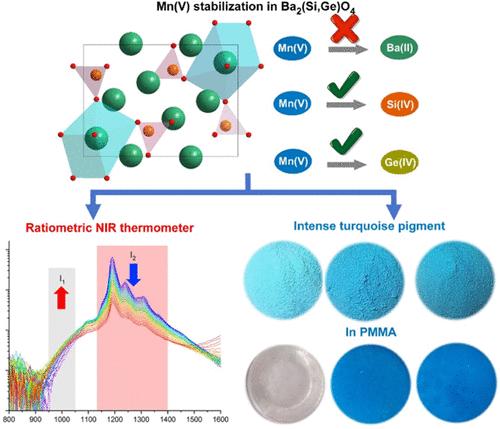一枪二鸟:Mn5+在Ba2(Si,Ge)O4中作为高效近红外温度计和强绿松石颜料的稳定性
IF 4.7
2区 化学
Q1 CHEMISTRY, INORGANIC & NUCLEAR
引用次数: 0
摘要
特殊氧化态过渡金属离子的发光是开发新型荧光粉的宝贵资源。五价锰(Mn5+)具有3d2电子构型,由于其稳定性困难,与Mn2+和Mn4+相比,报道较少。本研究采用固相反应法制备了Ba2(Si1-xGex)O4:Mn5+荧光粉。Mn5+在(Si,Ge)O4四面体中的成功稳定导致了明亮的绿松石色,在室温下具有强烈的NIR-II锐峰发射。用Ge4+取代Si4+后,1E-3A2跃迁的峰位置保持在1181 nm,而在x = 0.6时,相应的集成强度提高了150%。采用第一性原理密度泛函理论(DFT)计算了Ba2(Si,Ge)O4:Mn5+荧光粉的几何优化结构和电子结构变化。然后,将它们与观测到的发光性质联系起来进行讨论。研究发现,对基体成分的改性可以改善1E发射的加速热猝灭速率。温度可以从Mn5+1E与3T2的发光强度比中读取。这项工作代表了探索不寻常的Mn5+作为下一代NIR-II荧光粉和新颜料发色团的发射中心的一步。本文章由计算机程序翻译,如有差异,请以英文原文为准。

One Shoot Two Birds: Stabilization of Mn5+ in Ba2(Si,Ge)O4 as an Efficient NIR Thermometer and Intense Turquoise Pigment
Luminescence of transition metal ions in unusual oxidation states is a treasure for developing new phosphors. Pentavalent manganese (Mn5+), which possesses a 3d2 electron configuration, has been reported less compared to its Mn2+ and Mn4+ counterparts due to the difficulty in its stabilization. In this study, Ba2(Si1–xGex)O4:Mn5+ phosphors were synthesized by a solid-state reaction method. The successful Mn5+ stabilization in the (Si,Ge)O4 tetrahedron leads to a bright turquoise body color with a strong NIR-II sharp-peak emission at room temperature. By replacing Si4+ with Ge4+, the peak position of the 1E–3A2 transition remains at 1181 nm, while the corresponding integrated intensity is enhanced by 150% at x = 0.6. First-principles density functional theory (DFT) calculations were performed to explore the geometrically optimized structure and electronic structure variation of the Ba2(Si,Ge)O4:Mn5+ phosphor. Then, they are discussed in association with the observed luminescence properties. It is found that modification of the host composition could modify the accelerated thermal quenching rate of the 1E emission. Temperature can be read from Mn5+1E vs 3T2 luminescence intensity ratios. This work represents a step toward exploring the unusual Mn5+ as the emitting center for the next-generation NIR-II phosphors and chromophores for new pigments.
求助全文
通过发布文献求助,成功后即可免费获取论文全文。
去求助
来源期刊

Inorganic Chemistry
化学-无机化学与核化学
CiteScore
7.60
自引率
13.00%
发文量
1960
审稿时长
1.9 months
期刊介绍:
Inorganic Chemistry publishes fundamental studies in all phases of inorganic chemistry. Coverage includes experimental and theoretical reports on quantitative studies of structure and thermodynamics, kinetics, mechanisms of inorganic reactions, bioinorganic chemistry, and relevant aspects of organometallic chemistry, solid-state phenomena, and chemical bonding theory. Emphasis is placed on the synthesis, structure, thermodynamics, reactivity, spectroscopy, and bonding properties of significant new and known compounds.
 求助内容:
求助内容: 应助结果提醒方式:
应助结果提醒方式:


